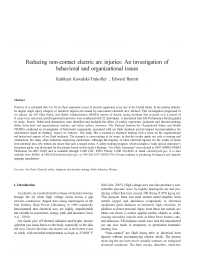Mining Publication: Reducing Non-Contact Electric Arc Injuries: An Investigation of Behavioral and Organizational Issues
Original creation date: November 2007
Problem: It is estimated that 5 to 10 arc flash explosions occur in electric equipment every day in the United States. In the mining industry the largest single injury category of electrical injuries are caused by non-contact electrical arcs. Method: This investigation progressed in two phases: (a) 836 Mine Safety and Health Administration (MSHA) reports of electric arcing incidents that occurred over a period of 11 years were reviewed, and (b) personal interviews were conducted with 32 individuals. A theoretical Safe Job Performance Model guided the study. Results: Behavioral dimensions were identified and included the effect of worker experience, judgment and decision-making ability, behavioral and organizational controls, and safety culture. Summary: The National Institute for Occupational Safety and Health (NIOSH) conducted an investigation of behavioral components associated with arc flash incidents and developed recommendations for interventions based on findings. Impact on Industry: This study fills a vacuum in electrical training with a focus on the organizational and behavioral aspects of arc flash incidents. The research is cross-cutting in its scope, in that the results apply not only to mining and construction, but many other industries employing electricians. Although the majority of mine electrical injuries are the results of burns from electrical arcs, few miners are aware that such a hazard exists. A safety training program, which includes a video and an instructor's discussion guide, was developed for electricians based on this study's findings.
Authors: KM Kowalski-Trakofler, EA Barrett
Peer Reviewed Journal Article - November 2007
NIOSHTIC2 Number: 20032882
J Saf Res 2007 Nov; 38(5):597-608
See Also
- Arc Flash Awareness
- Electric Shock Prevention
- Electrical Accidents in the Mining Industry, 1990-1999
- Look Up, Look Down, Look Out
- Modernization and Further Development of the NIOSH Mine Emergency Response Training System (MERITS), Phase 1
- Technology News 483 - Safety Training Tools for Rock Scaling Personnel
- Technology News 491 - NIOSH Releases Two New Safety Training Videos
- Technology News 502 - A New Training Video for Aggregate Operators: Aggregate Training for the Safety Impaired
- Technology News 524 - HazComWriter Compliance Tool for MSHA Rule 30 CFR Part 47 or OSHA Rule 29 CFR 1910.1200
- Understanding and Quantifying Arc Flash Hazards in the Mining Industry
- Content source: National Institute for Occupational Safety and Health, Mining Program


 ShareCompartir
ShareCompartir
